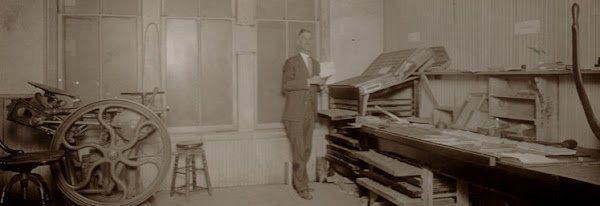
Here it is in all its naturally lighted glory. It was a lot of work but I'm pleased with the result. Everything is running smooth and easy. I didn't keep close track of how long it took but I would estimate at least 30 hours.
The platen was out of adjustment so I took care of that too; I'll have to make a final test once I get rollers and pull a few test proofs. To make the initial setting I set a machinist's sliding wedge gauge to type high with a micrometer. I then stacked up a pressboard, three sheets of bond and one sheet of tag and had them slightly hanging over the edge of a table. I placed the gauge on top and took a reading of the total thickness with the micrometer. This gave me a reading of about .945. I wasn't really concerned with the actual number but with getting an accurate reading of a standard packing and the height of the type combined. I reset the wedge gauge accordingly and then clamped it in a Vise-grip for a handle. Then I used it to set each corner of the platen so the gauge slides in snugly: easy in and out but no play.
On my old 8x12 I tried at first the standard four-corners lockup with large sorts to adjust the platen but this didn't work well for me. I adjusted it a second time using the above method and it made a dramatic, positive difference in the impression. It did so well that I never had to make another adjustment other than standard makeready. I used this method because those were the tools I had. I chose the packing I did because that is what is recommended in the standard works, with slight variations. I substituted bond paper for book and I left out the cover sheet. I did this to allow for a bit more adjustment with the packing when dressing the platen. I'll see what a few proofs look like and experiment with different packing and then make any final adjustments if necessary. I don't want or intend to adjust the platen often. I want to have it at a setting that is as versatile as possible for whatever I may want to print.
An interesting discovery is that this press, like my 8x12 and other older presses including Pearls, has rails that are lower than type high. I've never yet discovered a reason why the presses were made this way and have not been able to come up with a reason myself, but it seems this was fairly common. What this means in practise is that the rollers and trucks must be different diameters, in my case the trucks need to be 1/8" larger than the rails. This of course flies in the face of the standard view that rollers and trucks must be the same diameter to prevent slurring. Personally I don't believe this view is correct. I think the usual argument from physics/mathematics is wrong. In fact I think physics/mathematics proves just the opposite, that the relationship to the axis at any given point is the same. Clearly some presses were made so only rollers and trucks of a different size would work. If slurring and imperfect work was a necessary result these presses would have ended up in the Ancient Press Graveyard long ago and clearly they were. Some Pearls especially seem to garner high praise for even fine halftone work. What does seems obvious is that some presses, mostly older, use rollers and trucks of a different size and most newer presses use the same size. I don't think it matters in terms of the work produced, only in terms of what will work on a particular press, even the rational for these differences has been lost in the dim past. In any case, I will use 1 5/8" rollers with 1 3/4" trucks like the printer before me did for over 20 years and the printers before him did with this press.
Today at work I made a wooden base for the motor's speed control pedal that will attach to the right runner. I'll post a photo of it once it's installed. I'm pricing out rollers at this point. One quote I've had so far is about $450 for three rollers. OUCH! I've since recovered from the shock with only minor relapses and am pursuing my search further. I am hoping to find something in the $200 to $250 range. I'd even settled for a set of good, used rollers at this point. Hopefully I can get a set by the middle of January. They'll be rubber and I'm going to use the original cores that came with the press. Hopefully that will save a few bucks.
I have a few days of vacation tied in with the holidays and will probably lock up a cut, ink it with a brayer and pull a few impressions. I can't wait to be fully up and running and working on some projects. By the way, I'm looking for a spider chase, book chase, and skeleton chase if anyone has any for sale.
























